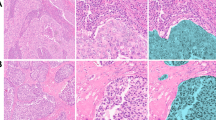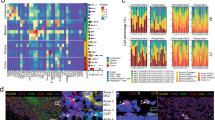Abstract
Background
In melanoma patients, microscopic tumor in the sentinel lymph-node biopsy (SLN) increases the risk of distant metastases, but the transition from tumor in the SLN to metastatic disease remains poorly understood.
Methods
Fluorescent staining for CD3, CD20, CD11c, and DNA was performed on SLN tissue and matching primary tumors. Regions of interest (ROI) were then chosen geometrically (e.g., tumor) or by fluorescent cell subset markers (e.g., CD11c). Each ROI was further analyzed using NanoString Digital Spatial Profiling high-resolution multiplex profiling. Digital counts for 59-panel immune-related proteins were collected and normalized to account for system variation and ROI area.
Results
Tumor regions of SLNs had variable infiltration of CD3 cells among patients. The patient with overall survival (OS) > 8 years had the most CD11c- and CD3-expressing cells infiltrating the SLN tumor region. All patients had CD11c (dendritic cell, DC) infiltration into the SLN tumor region. Selecting ROI by specific cell subtype, we compared protein expression of CD11c cells between tumor and non-tumor/normal tissue SLN regions. Known markers of DC activation such as CD86, HLA-DR, and OX40L were lowest on CD11c cells within SLN tumor for the patient with OS < 1 year and highest on the patient with OS > 8 years.
Conclusion
We demonstrate the feasibility of profiling the protein expression of CD11c cells within the SLN tumor. Identifying early regulators of melanoma control when the disease is microscopically detected in the SLN is beneficial and requires follow-up studies in a larger cohort of patients.






Similar content being viewed by others
References
Morton DL, Thompson JF, Cochran AJ, Mozzillo N, Nieweg OE, Roses DF, Hoekstra HJ, Karakousis CP, Puleo CA, Coventry BJ, Kashani-Sabet M, Smithers BM, Paul E, Kraybill WG, McKinnon JG, Wang HJ, Elashoff R, Faries MB, Group M (2014) Final trial report of sentinel-node biopsy versus nodal observation in melanoma. N Engl J Med 370:599–609 (2014PMC4058881)
Landow SM, Gjelsvik A, Weinstock MA (2017) Mortality burden and prognosis of thin melanomas overall and by subcategory of thickness, SEER registry data, 1992–2013. J Am Acad Dermatol 76:258–263
Whiteman DC, Baade PD, Olsen CM (2015) More people die from thin melanomas (1 mm) than from thick melanomas (>4 mm) in Queensland. Australia J Invest Dermatol 135:1190–1193
Grob JJ, Garbe C, Ascierto P, Larkin J, Dummer R, Schadendorf D (2018) Adjuvant melanoma therapy with new drugs: should physicians continue to focus on metastatic disease or use it earlier in primary melanoma? Lancet Oncol 19:e720–e725
Verver D, van Klaveren D, van Akkooi ACJ, Rutkowski P, Powell B, Robert C, Testori A, van Leeuwen BL, van der Veldt AAM, Keilholz U, Eggermont AMM, Verhoef C, Grunhagen DJ (2018) Risk stratification of sentinel node-positive melanoma patients defines surgical management and adjuvant therapy treatment considerations. Eur J Cancer 96:25–33
Gershenwald JE, Scolyer RA, Hess KR, Sondak VK, Long GV, Ross MI, Lazar AJ, Faries MB, Kirkwood JM, McArthur GA, Haydu LE, Eggermont AMM, Flaherty KT, Balch CM, Thompson JF (2017) Melanoma staging: evidence-based changes in the American joint committee on cancer eighth edition cancer staging manual. CA Cancer J Clin 67:472–492 (2017PMC5978683)
Holtzhausen A, Zhao F, Evans KS, Tsutsui M, Orabona C, Tyler DS, Hanks BA (2015) Melanoma-derived Wnt5a promotes local dendritic-cell expression of IDO and immunotolerance: opportunities for pharmacologic enhancement of immunotherapy. Cancer Immunol Res 3:1082–1095 (2015PMC4927300)
Beechem JM (2020) High-plex spatially resolved RNA and protein detection using digital spatial profiling: a technology designed for immuno-oncology biomarker discovery and translational research. Methods Mol Biol 2055:563–583
Toki MI, Merritt CR, Wong PF, Smithy JW, Kluger HM, Syrigos KN, Ong GT, Warren SE, Beechem JM, Rimm DL (2019) High-plex predictive marker discovery for melanoma immunotherapy-treated patients using digital spatial profiling. Clin Cancer Res 25:5503–5512 (2019PMC6744974)
Blank CU, Rozeman EA, Fanchi LF, Sikorska K, van de Wiel B, Kvistborg P, Krijgsman O, van den Braber M, Philips D, Broeks A, van Thienen JV, Mallo HA, Adriaansz S, Ter Meulen S, Pronk LM, Grijpink-Ongering LG, Bruining A, Gittelman RM, Warren S, van Tinteren H, Peeper DS, Haanen J, van Akkooi ACJ, Schumacher TN (2018) Neoadjuvant versus adjuvant ipilimumab plus nivolumab in macroscopic stage III melanoma. Nat Med 24:1655–1661
Amaria RN, Reddy SM, Tawbi HA, Davies MA, Ross MI, Glitza IC, Cormier JN, Lewis C, Hwu WJ, Hanna E, Diab A, Wong MK, Royal R, Gross N, Weber R, Lai SY, Ehlers R, Blando J, Milton DR, Woodman S, Kageyama R, Wells DK, Hwu P, Patel SP, Lucci A, Hessel A, Lee JE, Gershenwald J, Simpson L, Burton EM, Posada L, Haydu L, Wang L, Zhang S, Lazar AJ, Hudgens CW, Gopalakrishnan V, Reuben A, Andrews MC, Spencer CN, Prieto V, Sharma P, Allison J, Tetzlaff MT, Wargo JA (2018) Neoadjuvant immune checkpoint blockade in high-risk resectable melanoma. Nat Med 24:1649–1654
Tarhini AA, Floros T, Lin HM, Lin Y, Rahman Z, Ashraf M, Vallabhaneni P, Sander C, Rao UNM, Panelli M, LaFramboise WA, Kirkwood JM (2017) A unique gene expression signature is significantly differentially expressed in tumor-positive or tumor-negative sentinel lymph nodes in patients with melanoma. Melanoma Res 27:429–438 (2017PMC5657445)
Alessi C, Scapulatempo Neto C, Viana CR, Vazquez VL (2017) PD-1/PD-L1 and VEGF-A/VEGF-C expression in lymph node microenvironment and association with melanoma metastasis and survival. Melanoma Res 27:565–572
Chevolet I, Speeckaert R, Haspeslagh M, Neyns B, Kruse V, Schreuer M, Van Gele M, Van Geel N, Brochez L (2014) Peritumoral indoleamine 2,3-dioxygenase expression in melanoma: an early marker of resistance to immune control? Br J Dermatol 171:987–995
Messaoudene M, Perier A, Fregni G, Neves E, Zitvogel L, Cremer I, Chanal J, Sastre-Garau X, Deschamps L, Marinho E, Larousserie F, Maubec E, Avril MF, Caignard A (2015) Characterization of the microenvironment in positive and negative sentinel lymph nodes from melanoma patients. PLoS ONE 10:e0133363 (2015PMC4517810)
Ma MW, Medicherla RC, Qian M, Vega-Saenz de Miera E, Friedman EB, Berman RS, Shapiro RL, Pavlick AC, Ott PA, Bhardwaj N, Shao Y, Osman I, Darvishian F (2012) Immune response in melanoma: an in-depth analysis of the primary tumor and corresponding sentinel lymph node. Mod Pathol 25:1000–1010 (2012PMC3882943)
Movassagh M, Spatz A, Davoust J, Lebecque S, Romero P, Pittet M, Rimoldi D, Lienard D, Gugerli O, Ferradini L, Robert C, Avril MF, Zitvogel L, Angevin E (2004) Selective accumulation of mature DC-Lamp+ dendritic cells in tumor sites is associated with efficient T-cell-mediated antitumor response and control of metastatic dissemination in melanoma. Cancer Res 64:2192–2198
Rubel F, Kern JS, Technau-Hafsi K, Uhrich S, Thoma K, Hacker G, von Bubnoff N, Meiss F, von Bubnoff D (2018) Indoleamine 2,3-dioxygenase expression in primary cutaneous melanoma correlates with breslow thickness and is of significant prognostic value for progression-free survival. J Invest Dermatol 138:679–687
Munn DH, Sharma MD, Lee JR, Jhaver KG, Johnson TS, Keskin DB, Marshall B, Chandler P, Antonia SJ, Burgess R, Slingluff CL Jr, Mellor AL (2002) Potential regulatory function of human dendritic cells expressing indoleamine 2,3-dioxygenase. Science 297:1867–1870
Horton BL, Williams JB, Cabanov A, Spranger S, Gajewski TF (2018) Intratumoral CD8(+) T-cell apoptosis is a major component of T-cell dysfunction and impedes antitumor immunity. Cancer Immunol Res 6:14–24 (2018PMC5754226)
Long GV, Dummer R, Hamid O, Gajewski TF, Caglevic C, Dalle S, Arance A, Carlino MS, Grob JJ, Kim TM, Demidov L, Robert C, Larkin J, Anderson JR, Maleski J, Jones M, Diede SJ, Mitchell TC (2019) Epacadostat plus pembrolizumab versus placebo plus pembrolizumab in patients with unresectable or metastatic melanoma (ECHO-301/KEYNOTE-252): a phase 3, randomised, double-blind study. Lancet Oncol 20:1083–1097
Funding
Georgia Beasley is funded by the Society of Surgical Oncology’s Young Investigator award (2019), by the Duke Office of Physician-Scientist Development Technician Support Award, and NIH K08 CA237726-01A1. Dr. Farrow is supported by a National Institutes of Health T-32 grant (T-32-CA093245) for translational research in surgical oncology and by the PolkaDot Mama Melanoma Foundation.
Author information
Authors and Affiliations
Corresponding author
Ethics declarations
Conflict of interest
The authors have no relevant conflicts of interest to disclose related to this work.
Additional information
Publisher's Note
Springer Nature remains neutral with regard to jurisdictional claims in published maps and institutional affiliations.
Electronic supplementary material
Below is the link to the electronic supplementary material.
Rights and permissions
About this article
Cite this article
Beasley, G.M., Therien, A.D., Holl, E.K. et al. Dissecting the immune landscape of tumor draining lymph nodes in melanoma with high-plex spatially resolved protein detection. Cancer Immunol Immunother 70, 475–483 (2021). https://doi.org/10.1007/s00262-020-02698-2
Received:
Accepted:
Published:
Issue Date:
DOI: https://doi.org/10.1007/s00262-020-02698-2




